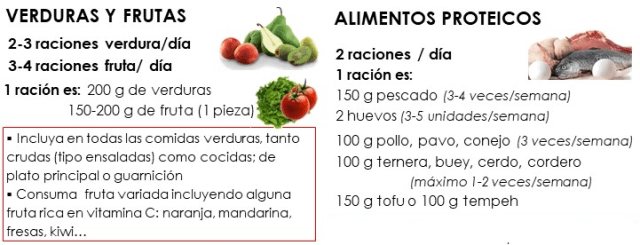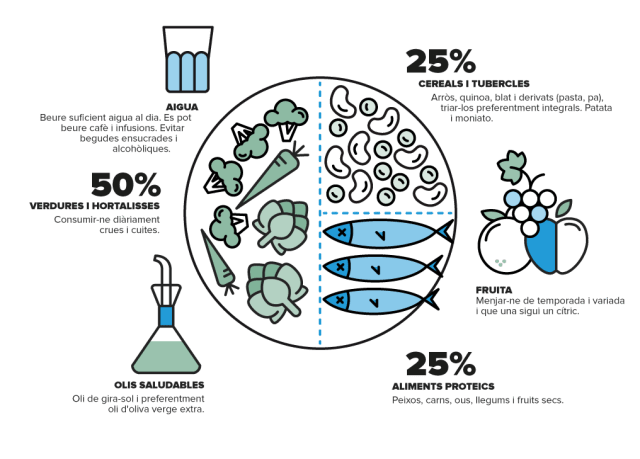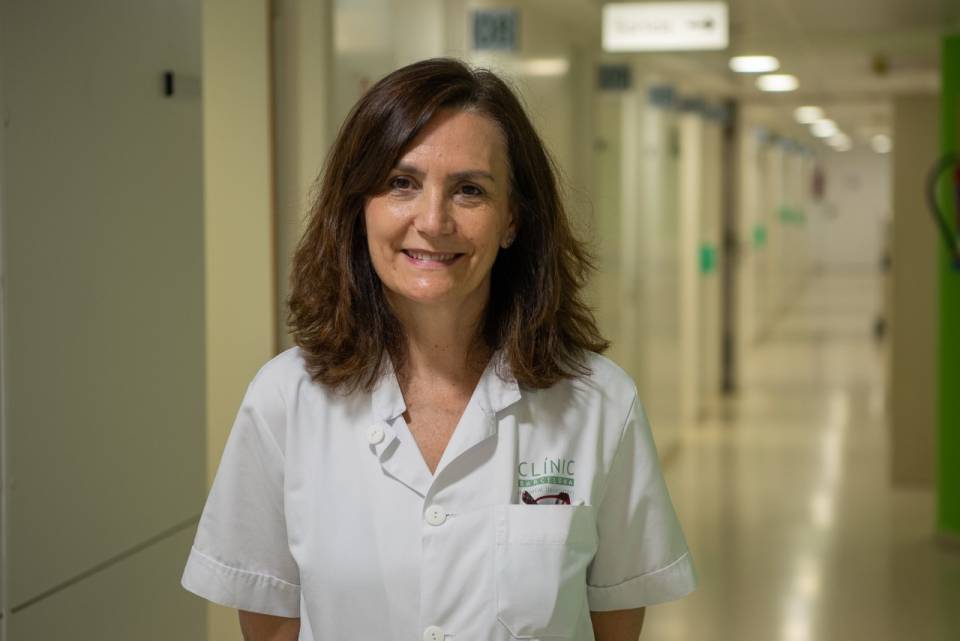It’s easier to follow good eating habits if you know how. That’s why a big part of nutrition professionals’ work is helping people understand how to follow a healthier diet. Cristina Montserrat, nutritionist at Hospital Clínic, understands this very well: “We need a lot more nutritional education”. In this interview, she gives us guidelines on how to shop well, and how to distinguish between healthy and unhealthy foods.
How do you get your patients to change their diet?
At the consultation we spend a long time explaining what a balanced diet is and how to plan it. First of all, we analyse the person’s eating habits, detect where there are imbalances and set goals. By recording meals, we assess intake and set targets. Afterwards, we look at what the target was and what has been done. We point out what has improved and we introduce another target. We always set small targets, because not everything can be achieved in just one day. “It is very important to involve the family because if a family member is part of the plan, it is much more effective.”
It is also very important to involve the family. First we ask questions to find out a bit about the family’s dietary dynamics, because when a family member or the whole family is part of the plan, it is much more effective.

(Fragment of the didactic material given to patients at the Nutrition Department at Hospital Clínic)
What advice would you give for when we go to the supermarket and want to buy healthy food? What should we look out for?
One of the things we can do is look at labels and look at the nutritional information and the list of ingredients. The nutritional information includes the energy value, fat, carbohydrate, fibre, protein and salt content. The list of ingredients is listed in order from the most abundant to the least abundant in that food as standard. For example, if we look at some chocolate biscuits and the first ingredient that appears is chocolate, it means they contain more chocolate than any other component.
I recommend doing this, because some foods can be misleading. You might see a food advertised as containing a high amount of a certain ingredient (for example fibre) but you have to look at the list to see if it really contains as much of that ingredient as the packaging tells you it does.
“You have to look at the amount of sugar, salt and saturated fats on the label.”
I would also recommend looking at the amount of sugar, salt and saturated fat in the product in order to choose the most suitable option according to which nutrients the person has to monitor. For example, if it’s salt, you would have to look at the product you want to buy, for example bread, to see which of the breads contains the least salt, and then get that one.
So the most important thing is that the food is low in fat, sugar and salt?
No, not just these. We can also go a step further and look at the nutritional value, in other words how much of the fat is saturated (less healthy) or unsaturated.
Looking at the nutritional value will also tell you about the calorie content. If a person is trying to lose weight, they also need to look at the calories. The label also tells us how much of the carbohydrates are sugars. If the total carbohydrates are 60g and 58g of these are sugars, this means the food contains a lot of free sugars. On the other hand, if it contains only 3g of sugar, this means most of the carbohydrates are long-chain carbohydrates, which are healthier than free sugars.

(Illustration of a “Healthy plate” with recommended proportions of the different food groups. Source: PortalCLÍNIC)
Can processed foods be healthy? Is there a trick to telling them apart?
My advice is that it’s better to eat fresh where possible, but there is a range of differences within processed foods. Pre-prepared products from major chains are not the same as a ready-made dish from the shop down the street. In the latter case, they will likely have put “more love” into it.
Now, however, there is a much greater trend towards healthy products, using olive oil instead of palm oil, and the label often states that the product has no added sugars... It’s still pre-prepared, but increasingly more attention is given to what society wants: we don’t have much spare time, but we want to eat well.
“If the processed food can be kept for a short time, it is a good sign.”
If the food is pre-prepared, but home-cooked, contains no preservatives and has to be consumed within a few days, this is a good sign.
Are there foods that look healthy, but aren’t? Which foods do you think are the most misleading?
I think you have to be very careful with foods in the dietary section. They put them there to highlight one ingredient, but we have to take the others into account too. For example, in some cases, the packaging says “high in fibre”, so someone who needs more fibre in their diet will choose this product. But if you look at the label, although it may be high in fibre, it has a lot of added sugar or less healthy fats.
We have to think about whether it’s worth consuming this food for the fibre. It may be cheaper to choose a normal, non-dietary product and look for fibre in other foods, for example, in a loaf of wholemeal bread, wholemeal rice or wholemeal pasta. Another example could be diet bars. You have to look at the ingredients and check them to see if they match what you’re looking for.
Then there is the issue of advertising and marketing. You can go to the supermarket with your idea and find that the most accessible and best-placed products are not the healthiest. You can end up with a lot of products in the trolley that were not what you came looking for, such as biscuits, chocolates, sweets, etc.
Do you think we are aware of the importance of food for our health?
Society is not at all aware of the impact food has on health. Although it’s true that every day more people are paying more attention to their diet, there is still a lack of education on this issue.
I notice it a lot during interviews with patients. Sometimes they don’t know which category a food falls into. Nutritionists very often divide foods into categories such as fruit, vegetables, grains, meat, etc. And we take it for granted that there are some things everyone knows, but for many people things aren’t so clear. We need a lot more nutritional education. For example, if you explain to someone that they can’t eat protein, they ask: “Okay, but I can still eat sausages, can’t I?”
Isn’t what we learn at school enough?
Because I have children, I’ve seen that they receive information about nutrition at school, and they talk about the food groups, etc. But it’s very vague knowledge.
“Schools can support education, but it’s the family that has to teach children how to eat.”
Ultimately, it’s the parents who buy food, who choose what they eat or what they take for lunch. Schools can support education, but it’s the family that has to teach children how to eat. How do we expect children to learn to eat well when often the parents, who are the people who organise these children’s meals, don’t have a basic understanding of food?
Do we know how to shop well?
The problem is that we should already have an idea of what we need to buy before going shopping. We should know how to plan a balanced and healthy food intake. But if you don’t have these basic notions about nutrition, it’s difficult to go to the supermarket and know how to choose products. People shop “as they go” because there is not this prior step of thinking: “I will do the shopping based on these criteria”.




